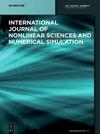Combined Mixed Convection and Radiation Heat Transfer in an Obstacle Wall Mounted Lid-driven Cavity
IF 1.4
4区 工程技术
Q2 ENGINEERING, MULTIDISCIPLINARY
International Journal of Nonlinear Sciences and Numerical Simulation
Pub Date : 2016-09-29
DOI:10.1515/ijnsns-2015-0095
引用次数: 5
Abstract
Abstract This paper presents a numerical investigation for laminar mixed convection flow of a radiating gas in a lid-driven cavity with a rectangular-shaped obstacle attached on the bottom wall. The vertical walls of the square cavity are assumed to be adiabatic, while other walls of cavity and obstacle are kept at constant temperature. The fluid is treated as a gray, absorbing, emitting and scattering medium. The governing differential equations consisting the continuity, momentum and energy are solved numerically by the computational fluid dynamics techniques to obtain the velocity and temperature fields. Discretized forms of these equations are obtained by the finite volume method and solved using the SIMPLE algorithm. Since the gas is considered as a radiating medium, besides convection and conduction, radiative heat transfer also takes place in the gas flow. For computation of the radiative term in the gas energy equation, the radiative transfer equation is solved numerically by the discrete ordinate method. The streamline and isotherm plots and the distributions of convective, radiative and total Nusselt numbers along the bottom wall of cavity are presented. The effects of Richardson number, obstacle location, radiation–conduction parameter, optical thickness and albedo coefficient on the flow and temperature distributions are carried out. Comparison between the present numerical results with those obtained by other investigators in the cases of conduction–radiation and pure convection systems shows good consistencies.障碍物壁上盖驱动腔内混合对流和辐射换热
摘要本文对底部壁面有矩形障碍物的盖驱动腔内辐射气体层流混合对流流动进行了数值研究。假设方形空腔的垂直壁为绝热壁,其余空腔壁和障碍物保持恒温。流体被视为一种灰色、吸收、发射和散射介质。利用计算流体力学技术对由连续性、动量和能量组成的控制微分方程进行数值求解,得到了速度场和温度场。用有限体积法得到了这些方程的离散化形式,并用SIMPLE算法求解。由于气体被认为是一种辐射介质,在气体流动中除了对流和传导外,还发生了辐射换热。对于气体能量方程中辐射项的计算,采用离散坐标法对辐射传递方程进行数值求解。给出了沿空腔底壁的流线图和等温线图以及对流数、辐射数和总努塞尔数的分布。研究了Richardson数、障碍物位置、辐射传导参数、光学厚度和反照率系数对流动和温度分布的影响。本文的数值结果与其他研究人员在传导辐射和纯对流系统中得到的结果相比较,显示出良好的一致性。
本文章由计算机程序翻译,如有差异,请以英文原文为准。
求助全文
约1分钟内获得全文
求助全文
来源期刊
CiteScore
2.80
自引率
6.70%
发文量
117
审稿时长
13.7 months
期刊介绍:
The International Journal of Nonlinear Sciences and Numerical Simulation publishes original papers on all subjects relevant to nonlinear sciences and numerical simulation. The journal is directed at Researchers in Nonlinear Sciences, Engineers, and Computational Scientists, Economists, and others, who either study the nature of nonlinear problems or conduct numerical simulations of nonlinear problems.

 求助内容:
求助内容: 应助结果提醒方式:
应助结果提醒方式:


